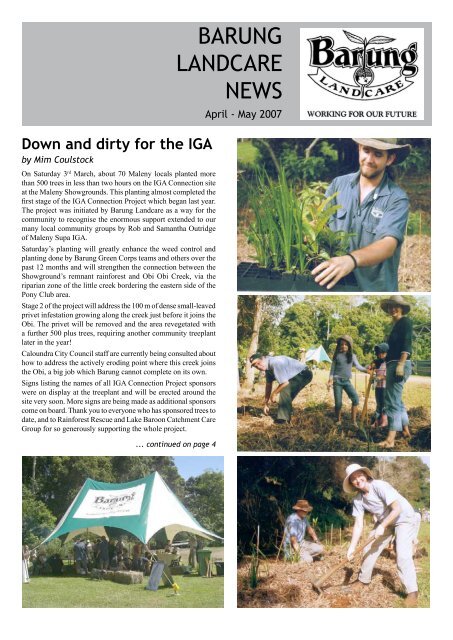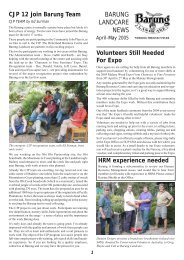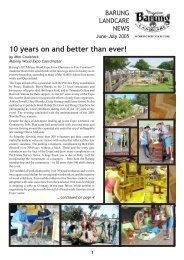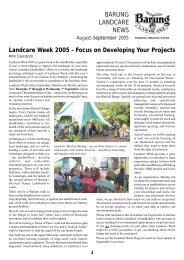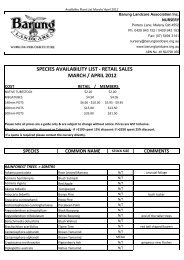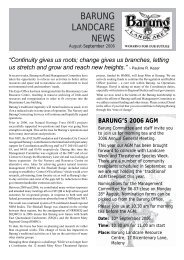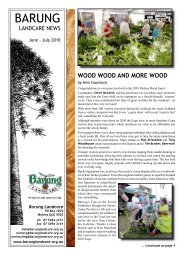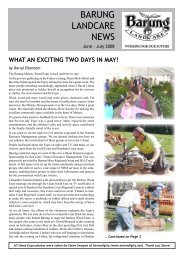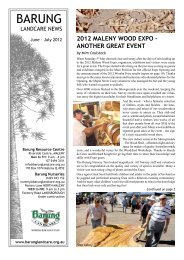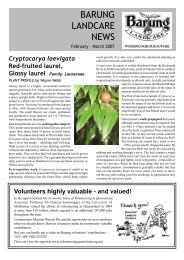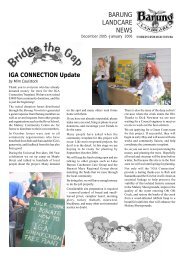Apr/May 2007 - Barung Landcare
Apr/May 2007 - Barung Landcare
Apr/May 2007 - Barung Landcare
Create successful ePaper yourself
Turn your PDF publications into a flip-book with our unique Google optimized e-Paper software.
Down and dirty for the IGA<br />
by Mim Coulstock<br />
On Saturday 3 rd March, about 70 Maleny locals planted more<br />
than 500 trees in less than two hours on the IGA Connection site<br />
at the Maleny Showgrounds. This planting almost completed the<br />
first stage of the IGA Connection Project which began last year.<br />
The project was initiated by <strong>Barung</strong> <strong>Landcare</strong> as a way for the<br />
community to recognise the enormous support extended to our<br />
many local community groups by Rob and Samantha Outridge<br />
of Maleny Supa IGA.<br />
Saturday’s planting will greatly enhance the weed control and<br />
planting done by <strong>Barung</strong> Green Corps teams and others over the<br />
past 12 months and will strengthen the connection between the<br />
Showground’s remnant rainforest and Obi Obi Creek, via the<br />
riparian zone of the little creek bordering the eastern side of the<br />
Pony Club area.<br />
Stage 2 of the project will address the 100 m of dense small-leaved<br />
privet infestation growing along the creek just before it joins the<br />
Obi. The privet will be removed and the area revegetated with<br />
a further 500 plus trees, requiring another community treeplant<br />
later in the year!<br />
Caloundra City Council staff are currently being consulted about<br />
how to address the actively eroding point where this creek joins<br />
the Obi, a big job which <strong>Barung</strong> cannot complete on its own.<br />
Signs listing the names of all IGA Connection Project sponsors<br />
were on display at the treeplant and will be erected around the<br />
site very soon. More signs are being made as additional sponsors<br />
come on board. Thank you to everyone who has sponsored trees to<br />
date, and to Rainforest Rescue and Lake Baroon Catchment Care<br />
Group for so generously supporting the whole project.<br />
BARUNG<br />
LANDCARE<br />
NEWS<br />
... continued on page 4<br />
<strong>Apr</strong>il - <strong>May</strong> <strong>2007</strong>
in this issue<br />
IGA Connection treeplant: Down & dirty.......... 1,4<br />
New Members........................................... 2<br />
ORNAMENTAL GARDEN: For the Frugivores......... 3<br />
IBISCA Lamington Project.............................. 3<br />
WILDLIFE PROFILE: Fruit Doves<br />
and Fragmentation................................... 5<br />
Montville SS Bunya Feast.............................. 5<br />
PLANT PROFILE: Corduroy tamarind................. 6<br />
Farm Forestry land for sale........................... 6<br />
Natural Sequence Farming............................ 7<br />
OPPORTUNITIES AND EVENTS......................... 8<br />
NURSERY NOTES: Irrigation benefits................. 9<br />
BARUNG CONTRACTING: Bush Regeneration...... 10<br />
WEED WATCH ONE: BL Paspalum UPDATE.......... 11<br />
GRANT FUNDING....................................... 11<br />
BUTTERFLIES OF THE RANGE: Monarch............. 12<br />
WEED WATCH TWO: Biological control............. 13<br />
WEED WATCH THREE: Weed folders review........ 13<br />
Thank You to, Letters ................................ 14<br />
TURKEY TANGENTIAL: Wilderness Garden..... 16,15<br />
barung membership rates<br />
Individual / family membership $ 20 pa<br />
Business membership<br />
$ 55 pa<br />
Business sponsorship<br />
$275 pa<br />
Donations of $2 or more are tax deductible.<br />
When your BUSINESS supports <strong>Barung</strong> <strong>Landcare</strong>,<br />
you will be acknowledged in the bimonthly<br />
<strong>Barung</strong> <strong>Landcare</strong> News (800 distribution) and at<br />
<strong>Barung</strong> displays, and you are entitled to three<br />
free trees and discounts on plant purchases at<br />
the Nursery.<br />
Contact the office at <strong>Barung</strong> <strong>Landcare</strong> on phone<br />
5494 3151 or email barungadmin@big.net.au<br />
for a form.<br />
WELCOME TO NEW MEMBERS<br />
(Compiled by Val Phillips)<br />
Bill Freeman<br />
John & Ann Wood<br />
Steve Hills<br />
Dal & Pam Fea<br />
Heather Wood<br />
Helen Meredith<br />
Chris Rew<br />
Warren & Janet Ausell<br />
Michael & Renate Cretney<br />
Carolyn Willadsen<br />
Chris & Deb Bourke<br />
B&L McFarlane<br />
Walter Bons<br />
Phil Harrison & Lani Donahaye<br />
McCullah/Steele<br />
Janet Carew<br />
THANK YOU FOR YOUR LANDCARE SUPPORT<br />
Opening Hours<br />
MONDAY TO FRIDAY<br />
<strong>Barung</strong> Nursery & Resource Centre/Office<br />
8.30 am – 4.00 pm<br />
SATURDAY<br />
<strong>Barung</strong> Nursery only<br />
9.00 am – 12.00 pm<br />
DEADLINE – Wed 16 th <strong>May</strong><br />
for June–July <strong>2007</strong><br />
Newsletter contributions<br />
Please renew your membership -<br />
your support is very important<br />
to <strong>Barung</strong>.<br />
THANK YOU<br />
Please keep showing your ...<br />
<strong>Barung</strong><br />
Community Benefit key tags<br />
... when shopping at Maleny IGA<br />
<strong>Barung</strong> gratefully acknowleges funding & sponsorships from:
For the Frugivores<br />
THE ORNAMENTAL GARDEN by Joan Dillon<br />
We’ve had some less common garden visitors lately; two<br />
female regent bowerbirds. We occasionally catch a glimpse<br />
of the gorgeous black and gold male but he doesn’t usually<br />
come so close to the house. The females were attracted by<br />
the fruit on a Decaspermum humile and I was reminded of<br />
the importance of fruiting trees and shrubs to many of the<br />
local birds. Decaspermum with its small leaves and neat<br />
habit is a useful addition to any garden.<br />
Our assorted figs in the revegetation/regeneration always<br />
support a range of pigeons from the wompoo down to the<br />
little greenwings, plus a substantial flock of figbirds and<br />
increasing numbers of lorikeets. The lorikeets are also<br />
attracted to the tiny sweet fruit on the native mulberry<br />
Pipturus argenteus, which the birds do love it as a source of<br />
small insects as well as fruit. Honeyeaters and yellow robins<br />
search amongst the leaves and twigs for tiny caterpillars.<br />
A pioneer species which attracts the brown turtle doves to<br />
its fruit is Homolanthus populifolius, and crows (ravens)<br />
seem to like the fruit of Macaranga tanarius. The bright<br />
purple fruit of Callicarpa pedunculata is both decorative<br />
and popular, as is the creamy coloured fruit of Psychotria<br />
loniceroides. This one comes up all over the place and<br />
I suspect the Lewin’s honeyeaters are responsible for<br />
spreading it. The brush turkeys took a liking to the blue fruit<br />
of Dianella congesta, and just about stripped the plants.<br />
Callicarpa pedunculata fruit. [Photo by Ian Dillon]<br />
Something is enjoying the fruit of the Davidson plum as I’m<br />
finding pecked fruit on the ground, and I’m waiting to find<br />
out what will be attracted to the Acronychia oblongifolia,<br />
now flowering heavily. Varied trillers love the fruit of the<br />
red bean Dysoxylum mollissimum (Dysoxylum muelleri) and<br />
seasonal visitors like the black-faced cuckoo shrike move<br />
from fig to wild raspberry and back again.<br />
The native olives Olea paniculata fruited heavily last year<br />
and kept the figbirds fed for weeks. When I went to collect<br />
some rosewood seed for propagation it was all gone and<br />
there was none on the ground. Something had dined well.<br />
Adding figs to the revegetation mix provides fruit for flying<br />
foxes as well as birds and hopefully reduces the impact on<br />
local orchards. Our resident and visiting frugivores provide<br />
endless pleasure and entertainment and help to disperse the<br />
local species.<br />
<br />
More about the IBISCA<br />
Lamington Project<br />
by Gretchen Evans & Lin Fairlie<br />
Not insects this time, but macrofungi<br />
Last issue of <strong>Barung</strong> News, Petrus wrote<br />
about the IBISCA project. This time we<br />
would like to tell you about an associated<br />
project in which we have been involved,<br />
called BATH – Biodiversity at the Heights.<br />
We are both members of Queensland Mycological<br />
Society (QMS) and have participated<br />
in two macro-fungal surveys, one last<br />
November and one recently in February.<br />
All the 20 sites were not covered because there were only 13<br />
volunteers and 3 days in which to do the surveys. Also there was<br />
only one professional mycologist, Nigel Fechner, who is half-time<br />
on macro fungi at the Queensland Herbarium, but a number of<br />
our colleagues were very knowledgeable.<br />
During our recent visit we discovered, photographed and<br />
described about 150 different specimens. As each new fungus<br />
is found, detailed descriptions of its size, colour and substrate<br />
are recorded and photographs taken. Then, after an identifying<br />
number has been assigned to the specimen, it is collected and<br />
returned to base for further description. Many fungi were really<br />
beautiful with varying colours, shapes and textures. Many were<br />
of the ‘mushroom’ type, but we did find some rare ones such as<br />
a Mutinus sp., which is a type of ‘stinkhorn’, and another which<br />
has never been found in Queensland before, a Chlorosplenium sp.,<br />
which was a beautiful bluey-green ascomycete or cup fungi.<br />
Unfortunately there are ‘weed’ fungi too. We found quite large<br />
infestations of Favolaschia and the spread of this fungus certainly<br />
needs research. However there is very little money available for<br />
macrofungal research, even though there is a growing recognition<br />
of the association between many individual Australian tree<br />
species and specific fungi.<br />
QMS has a regular monthly meeting at 7 pm on the second<br />
Tuesday of each month in the Herbarium lecture room at the Mt<br />
Coot-tha Botanical Gardens. Everyone is welcome. Sunshine<br />
Coast members are planning outings later in the year to look for<br />
local fungi, so we will keep you informed of dates and details.<br />
Driving into <strong>Barung</strong><br />
Sloooowly, please<br />
If you need to bring your vehicle into <strong>Barung</strong><br />
(instead of parking outside), PLEASE drive<br />
very, very slowly and carefully.<br />
The dragons are very nimble, but small children<br />
who may be visiting the plant nursery<br />
don’t have such quick and instinctive reactions<br />
for avoiding vehicles (or any at all,<br />
really).<br />
Please keep <strong>Barung</strong>’s driveway safe.<br />
Drive sloooowly.
IGA Treeplant<br />
... continued from page 1<br />
Many thanks to Montville Mist and our local councillor,<br />
Dick Newman for sponsoring the water and<br />
BBQ for treeplanters who’d been planting in very<br />
hot conditions. Both were greatly appreciated and<br />
enjoyed as they provided a time and place for friendly<br />
conversation after the morning’s work.<br />
Thanks especially to <strong>Barung</strong> Contracting Services,<br />
office staff and the CJP team who all contributed to<br />
the set-up and organisation prior to the treeplant, as<br />
well as giving up their time to ensure the morning<br />
flowed so smoothly.<br />
And finally, an especially big ‘thank you’ to everyone<br />
who planted trees. As Rob Outridge commented,<br />
the morning’s work ‘…demonstrated what fantastic<br />
results can be achieved with teamwork by a diverse<br />
group of enthusiastic and energetic people.’<br />
If you would like to sponsor a tree by donating at least<br />
$10 towards the IGA Connection Project and have<br />
your name added to a permanent sign at the site, please<br />
phone <strong>Barung</strong> (5494 3151) or call into the office in<br />
Bicentenary Lane and leave your details.<br />
Page 1, anticlockwise from top: Jake and some <strong>Barung</strong><br />
babies; Rob, Emily, Lucy & Sam Outridge; Diana O’Connor;<br />
the famous <strong>Barung</strong> bar-be-que and ’ave-a-chat tent.<br />
This page, clockwise from top: the <strong>Barung</strong> community crew<br />
putting the <strong>Barung</strong> babies to bed; Ryan & Wayne Webb,<br />
Brosie & John Muir and Banjo Brunckhorst; Emma’s children<br />
from Rainforest Rescue.<br />
[Photos by Mim Coulstock and Fuschia Collard]<br />
<strong>Landcare</strong> Queensland<br />
[Virtual] Bookshop<br />
With a focus on all things landcare related, the new<br />
<strong>Landcare</strong> Queensland online bookshop provides<br />
publications on working and playing in the natural<br />
environment. Members of <strong>Landcare</strong> Queensland<br />
receive a discount (membership is only $20 a year.<br />
If you have requests for publications, please email<br />
kerri@landcare.com.au<br />
Join <strong>Landcare</strong> Queensland<br />
Join <strong>Landcare</strong> Queensland before 15 <strong>Apr</strong>il and receive<br />
Kangaroos of Queensland (RRP $12.95) for free.<br />
(You must write ‘free kangaroos book’ on your form<br />
to receive the publication.)<br />
Phone: 07 3211 4413<br />
Website: www. landcare.org.au<br />
‘From waste-d-water to pure water’<br />
Water Quality Star Rating<br />
by Jenifer Simpson<br />
Jenifer Simpson’s guide builds a case for rethinking our attitudes to waste-dwater.<br />
In this highly readable guide, we discover what we put into water, how<br />
we take it out again and how we can be sure that it has been taken out.<br />
Moving away from the largely misunderstood ‘primary, secondary, tertiary’<br />
descriptions of effluent quality, Jenifer introduces a stunningly logical concept<br />
– she awards stars. The more stars, the more opportunities to reuse this precious<br />
resource – simple and straight forward – just like the booklet itself.<br />
Cost:<br />
FREE to community groups and individuals<br />
Online: www.scec.org.au/pdfs/From-waste-d-water-to-pure-water.pdf<br />
Contact: Natasha Wright on 3503 1425 or<br />
nwright@seqcatchments.com.au<br />
Support <strong>Barung</strong> <strong>Landcare</strong> through your Business<br />
Forms available from <strong>Barung</strong> <strong>Landcare</strong> Office
Fruit Doves and<br />
Fragmentation<br />
WILDLIFE PROFILE by Susie Duncan<br />
Fruit doves are real jewels in our local rainforests. The<br />
wompoo fruit-dove is possibly the best known because<br />
of its wacky but beautiful call ‘wolloka - ooo’. These are<br />
large doves, around the size of a currawong, but they’re<br />
often unseen because of their quiet movements in the dense<br />
rainforest foliage. Falling fruit can often be the first signal<br />
that they’re up there. Once seen they are unforgettable, with<br />
their rich plum purple chest, deep yellow underparts, bright<br />
green back and tail, and white head.<br />
The other two fruit doves are about half the size of the<br />
wompoo and also very brightly coloured: the superb fruitdove<br />
male has a beautiful purple crown and the rose-crowned<br />
fruit-dove male and female both have rose crowns.<br />
These birds are serious fruit eaters (frugivores) of the<br />
rainforest and are quite particular about what fruits they<br />
will eat. A study by Cath Moran and others (2004) in the<br />
Blackall and Conondale ranges showed that in this region<br />
fruit doves were most abundant in the extensive tracts of<br />
rainforest that remain. They were much less abundant in<br />
smaller rainforest remnants, and even more rare in patches<br />
of regrowth rainforest.<br />
These three species are known to fly across cleared land, so<br />
what was stopping them from hanging out in the remnants<br />
(which had similar food plants to the extensive tracts of<br />
rainforest) and the regrowth? It was fairly evident that the<br />
pioneer vegetation of the regrowth often didn’t have the<br />
right food plants or they weren’t yet bearing enough food<br />
to be attractive to the fruit doves. But with the remnants,<br />
the answer seems to lie in reward for effort. Flying long<br />
distances across cleared land without a refuelling site along<br />
the way just doesn’t make energetic sense for a fruit dove.<br />
In extensive areas of rainforest they can more readily cover<br />
big distances because there are sure to be a few snacks enroute.<br />
And of course, flying across open country also carries<br />
the risk of becoming dinner for a raptor such as a peregrine<br />
falcon. So not too many fruit doves end up in remnants,<br />
even though there might be fruit available.<br />
In the story of the fruit doves, the implications are not just<br />
for the conservation of the birds, but also the rainforest<br />
plants whose seeds they distribute. Other frugivores which<br />
eat a wider range of fruits may not distribute some of the<br />
fruits that the fruit doves eat. For example, fruit doves are<br />
known to be able to swallow larger fruits and seeds than<br />
most other frugivore birds by virtue of their distensible<br />
gapes. They also have ‘lump-lined stomachs’ which might<br />
treat seeds differently from other frugivores and result in<br />
greater germination success.<br />
The upshot of all this is that in remnant and regrowth<br />
rainforest the decline of fruit doves is likely to lead to a<br />
decline in plants whose seeds they specifically distribute.<br />
This will be particularly so where those fragments of<br />
rainforest are distant from extensive areas of rainforest. In<br />
effect there may be local extinctions of some plant species<br />
<br />
in isolated fragments, and it is quite likely that the weed<br />
species that other frugivores distribute (camphor laurel,<br />
privets, lantana) will increase.<br />
So what can we do for these beautiful birds and their<br />
favourite food plants? We can direct-seed or replant these<br />
species in the fragments. But in the long run we need to<br />
recover the connections between extensive areas of forests,<br />
remnants and regrowth. Not narrow corridors, but broad<br />
bands of forest that will provide contiguous cover and food<br />
for all the species integral to the rainforest.<br />
Reference: C Moran, CP Catterall, RJ Green and MF Olsen<br />
(2004) Fates of feathered fruit-eaters in fragmented forests.<br />
In Conservation of Australia’s forest fauna (2 nd ed.), edited<br />
by Dan Lunney.<br />
Montville State School<br />
Annual Bunya Feast<br />
by Frith Duggan<br />
Have you noticed that the Montville School logo is a bunya<br />
tree?<br />
For several years now, Montville State School students have<br />
been involved in celebrating the bunya feasts which are part of<br />
the Gubbi Gubbi history in this area. There has been Aboriginal<br />
dancing, stories and bush tucker food. All year levels and lots of<br />
parents participate at this half-day celebration, which is usually<br />
held in March while there are still plentiful bunya nuts.<br />
Traditionally bunya feasts were held every third year. After last<br />
year’s gigantic event in the Family Russell Park, the Montville<br />
State School P&C organised a smaller event for this year on<br />
Monday 12 March at the Montville Village Green.<br />
The whole school was delighted to hear Beverly Hand from the<br />
Gubbi Gubbi tribe present<br />
an interactive talk with<br />
students before trying<br />
some roasted bunya nuts.<br />
Montville State School<br />
and the P&C feel very<br />
privileged that Bev could<br />
pass on traditional knowledge<br />
and heritage which is<br />
such an important part of<br />
this area’s history.<br />
Thank you Bev! We can’t<br />
wait to hear the story<br />
about the wedge-tailed<br />
eagle.<br />
Bev Hand was<br />
invited to speak<br />
at Montville<br />
State School’s<br />
Bunya Feast.<br />
[Photos by<br />
Fuschia Collard]
Mischarytera lautereriana<br />
Corduroy tamarind<br />
Family: Sapindaceae<br />
PLANT PROFILE<br />
by Wayne Webb & Diana O’Connor<br />
Mischarytera lautereriana is a very<br />
handsome tree on account of its dense<br />
elegant foliage. The leaves are compound,<br />
about 25 cms long, divided into 10 to 20<br />
narrow leaflets with wavy margins giving<br />
a lovely feathery look to the foliage. The<br />
shiny leaflets are hairless, bright green<br />
and entire with small teeth near the apex.<br />
There is a large pulvinus (swelling) at the<br />
base of the leaf stem. Bright red flushes of<br />
new growth are very ornamental.<br />
Corduroy tamarind is a small to medium<br />
sized tree of subtropical rainforest growing<br />
to around 15 m, although old specimens to<br />
30 m can be found in mature rainforests.<br />
It occurs north from Mt Glorious (near<br />
Brisbane) to the Windsor Tableland<br />
(west of the Daintree). It is endemic to<br />
Queensland. It is quite common locally,<br />
often found close to watercourses. Examples may be seen in<br />
Mary Cairncross Scenic Reserve down near the piccabeen<br />
grove. Other places include Flaxton, Elaman Ck, Peachester,<br />
Landsborough and Mapleton.<br />
The trunk has horizontally ridged grey bark, common in<br />
this family. The common name comes from the strangely<br />
undulating sapwood (like corduroy) lying below the bark,<br />
and the sharp taste (like tamarind) of the fruit’s edible aril.<br />
Corduroy tamarind bears tiny fragrant flowers in panicles<br />
near the ends of branches in <strong>May</strong> and June. It usually<br />
by Ashley Sewell and Mim Coulstock<br />
Mischarytera lautereriana<br />
[Photo by Wayne Webb]<br />
When Patricia and Phil Jacobs came from Sydney to Maleny in<br />
1991, they purchased a 2.6 ha property on Gardners Lane and<br />
proceeded to build their house and to rehabilitate and landscape<br />
the surrounding ex-dairy farm land. With their strong commitment<br />
to the community, especially when <strong>Barung</strong> <strong>Landcare</strong> was in its<br />
infancy with Lexie Forbes at the helm, Patricia and Phil provided<br />
invaluable support operating and even building the office.<br />
Phil and Patricia were early and strong supporters of what was to<br />
become known ‘farm forestry’. Using the ‘Jack Mitchell Method’<br />
of planting 10-12 species of cabinet timbers per hectare, two<br />
small 1000 m farm forestry plots were established in 1992-94 on<br />
their property in Gardners Lane. These plantings have been very<br />
successful, and have provided sound demonstration opportunities<br />
for interested and potential farm forestry growers in the region.<br />
Phil and Patricia’s sites are still used for <strong>Barung</strong> Farm Forestry<br />
tours for local, school and overseas visitors.<br />
Since Phil passed away in 2001, Patricia has maintained their<br />
property in excellent condition in his absence. However, to make<br />
<br />
fruits in November and December (though in <strong>2007</strong> fruiting<br />
occurred in January). Like many rainforest species, it may<br />
fruit heavily in some years and hardly at all in other years.<br />
The fruit is a three-lobed capsule (although often only one<br />
lobe will develop) that opens upwards to expose the fleshy<br />
orange aril which encases a large brown seed.<br />
Corduroy tamarind makes a very attractive garden or park<br />
tree. Young trees have a stately conical outline,<br />
with a dense canopy of beautiful wavy foliage.<br />
Older trees develop a rounded crown. This<br />
species is hardy in full sun, tolerates light frost,<br />
and will grow in a variety of soils including<br />
shallow infertile soils. It establishes faster with<br />
some protection and good mulching when<br />
young. Larger trees in the rainforest often have<br />
a carpet underneath of young ones often up to<br />
one metre high. This suggests it could be mass<br />
planted in heavily shaded areas of the garden<br />
to produce a beautiful ferny understorey, the<br />
low light levels suppressing growth.<br />
The juicy orange aril is edible, though very<br />
tart. If removed carefully when cleaning the<br />
seed, the aril can be used to make a fantastic<br />
bright orange ‘bush-tucker’ jam – great with<br />
scones and whipped cream! The fruit is also<br />
sought out by rainforest birds such as the<br />
wompoo fruit-dove. The wood of this species has been used<br />
for flooring and scantling.<br />
Corduroy tamarind is easily propagated from seed, which<br />
germinates in a few weeks. The seed is subject to insect<br />
attack while on the tree, so when collecting soak the seed<br />
overnight in water to drown any grubs. Remove the flesh<br />
and discard any seeds that are distorted before sowing. If<br />
seeds can’t be sown immediately, they may be soaked for<br />
one or two weeks; they will loose viability if allowed to<br />
dry out for too long.<br />
Phil and Patricia Jacobs: <strong>Barung</strong> & Farm Forestry Stalwarts<br />
the property more manageable for herself, she has decided to<br />
subdivide and sell one block, containing one of the farm forestry<br />
plots, hopefully to a sympathetic farm forestry or landcaring<br />
enthusiast.<br />
It is hoped that the purchaser will continue to permit <strong>Barung</strong><br />
<strong>Landcare</strong> to use the forestry plot for demonstration and educational<br />
purposes.<br />
FARM FORESTRY LAND FOR SALE<br />
1.021 hectares of ‘Farm Forestry’ land<br />
including a mixed species cabinet timber tree plot<br />
and spring-fed dam<br />
in North Maleny<br />
(part of the property of the late Phil Jacobs)<br />
Phone: Patricia Jacobs on 5494 3464
Australian Landscapes:<br />
How they work, how to read them, how to fix them<br />
by Jonothan Waites<br />
Wouldn’t we all like to know? Peter Andrews, of Australian Story<br />
fame (or infamy!) and author of Back from the Brink, has been<br />
studying Australian landscape processes for more than 30 years.<br />
The result of his observations is a land management methodology<br />
he calls Natural Sequence Farming (NSF). NSF is based on<br />
Peter’s theory of how nutrients (carried by water) flow through<br />
and are recycled within our landscapes with the essential aid of<br />
vegetation.<br />
<strong>Barung</strong> <strong>Landcare</strong> recently supported Rosetta Books (as part of<br />
their author series of talks) in hosting an evening talk by Peter<br />
where he outlined his theory and some of its aspects to an interested<br />
audience in the Maleny Showgrounds Pavilion.<br />
NSF as a land management tool is a holistic (and therefore potentially<br />
ecological) approach to evolving landscapes to mimic the<br />
pre-European (or even pre-homo sapiens) valley floor feature<br />
known as the ‘swampy meadow – chain of ponds complex’.<br />
Through many years of keen observation, Peter has identified<br />
landscape functions and recognised the natural sequences which<br />
occur within them that enable ecosystems on this continent<br />
to endure. One such feature is landscape water storage. In the<br />
northern hemisphere water tends to be stored in large open water<br />
bodies. However in our dry, hot continent with high evaporation<br />
rates, water was stored successfully in the soil of the floodplain;<br />
Peter likens such floodplain storage to grass-covered dams.<br />
According to scientist John Williams (Founding member of the<br />
Wentworth Group of Concerned Scientists, Commissioner for<br />
Natural Resources for NSW), NSF is about how landscapes work,<br />
how to read them and how to put them back together again.<br />
Essentially, applying NSF techniques reconnects streams and<br />
rivers to the valley landscapes (catchments) through which they<br />
flow. This is important in terms of ecosystem function because it<br />
allows water (and the nutrients it transports) to be retained within a<br />
landscape for longer. This gives the plants growing there a longer<br />
period of access to these resources, ensuring them a better chance<br />
of reaching their greatest productive potential. The rate of water<br />
flow through a landscape is considerably slowed and its energy<br />
dissipated by the introduction of structures such as ‘leaky weirs’.<br />
These structures may consist of substantial engineering works<br />
(eg banks, barriers) or simple obstructions (eg rocks, sediments,<br />
trees, branches, leaves, grass).<br />
Valley floors are the fertility collection zone of a landscape. Valley<br />
floors which have a functional ‘chain of ponds’ floodplain system<br />
slow the movement of fertility through the landscape, facilitating<br />
the uptake of minerals and nutrients by plants which are then consumed<br />
by livestock, birds and bees. These animals then transfer<br />
that fertility to the top of the hills from whence water (aided by<br />
gravity) spreads it back down the slope (moving both above and<br />
below the ground). This is one of nature’s many cycles by which<br />
landscapes sustain themselves.<br />
An ideal farm layout, Peter believes, is one that is divided into<br />
thirds as follows; one-third forest and scrub (on the high ground<br />
– accumulating fertility under the trees), one-third agricultural<br />
(mid-slope – cropping, exploiting fertility) and one-third recovery<br />
area (valley floor – grass and weeds capturing fertility).<br />
Now these figures aren’t hard and fast, and the pattern could<br />
also be repeated several times on a slope, in a paddock or over a<br />
property. In a grazing situation it would be two-thirds grassland<br />
and one third forest area, with the forest area being selectively<br />
<br />
grazed (this, of course, depends on the purpose of the forest and<br />
other associated factors – not rainforest remnants please). Peter<br />
suggests that applying this method aimed at accumulating and<br />
retaining nutrients can result in the agricultural third being up to<br />
five times more productive. This is based on the supposition that<br />
pasture grass and crops extract fertility while weeds and trees<br />
add fertility to the land.<br />
A brief word about weeds. Many of the critics of NSF have made<br />
much of Peter’s use of weeds, particularly the dreaded willow.<br />
Peter doesn’t divide plants into natives and exotics, but rather<br />
assesses a species according to its function in the landscape. He<br />
regards many of our herbivorous weeds as great fertility accumulators<br />
which only occur in a landscape to correct a mineral<br />
deficiency or a particular soil condition. Willows, he contends,<br />
have functioned more successfully than natives would have where<br />
he has used them for the specific purposes he has had in mind.<br />
Focussing on one aspect, such as the use of weeds or a particular<br />
weed species, can distract us from the key principles of NSF, with<br />
the result that we miss the point.<br />
It is claimed that NSF properly applied can rectify a range of<br />
environmental problems such as salinity, erosion, eutrophication<br />
of waterways, and rising water tables. A CSIRO team was formed<br />
to evaluate the performance of NSF at Peter Andrew’s property<br />
‘Tarwyn Park’ in the Hunter Valley. Its report endorsed the general<br />
approach. In other words, ecologically NSF makes sense. Apart<br />
from the science, practical results speak for themselves. Photos<br />
of Peter’s property during the current drought show a body of<br />
green feed covering his valley floor, in stark contrast to the brown<br />
paddocks of neighbouring properties.<br />
The report also concluded that more monitoring and evaluation of<br />
NSF was needed in other areas along with its practical application<br />
in other landscapes.<br />
Funding available to trial NSF<br />
To this end, the regional body SEQ Catchments has obtained<br />
funding to set up some trials in this region. If you are interested<br />
in trialling NSF on your property, please contact me at <strong>Barung</strong><br />
<strong>Landcare</strong> or SEQ Catchments directly. It would be interesting<br />
to investigate NSF’s applicability to our landscapes with their<br />
predominance of first order streams and to determine just how<br />
the methodology might be practiced here. In an area such as ours<br />
with intensive agricultural land use, an increasing population and<br />
high rainfall (well usually), a management approach that enhances<br />
the retention of our increasing nutrient loads on the land and out<br />
of our streams deserves to be considered.<br />
This has been a necessarily brief overview of NSF; a simple<br />
system but a complex one to implement on a specific property<br />
or landscape. Only some of the environmental aspects have been<br />
touched on here, and there are also social and economic implications<br />
that need to be thought through. The <strong>Barung</strong> Library has a<br />
copy of Peter Andrews’s book Back from the Brink: How Australian<br />
landscapes can be saved available for loan to members as well<br />
as a double DVD, Natural Sequence Farming Workshop: Defining<br />
the science & the practice. There are also two websites:<br />
www.nsfarming.com and www.naturalsequencefarming.com.au<br />
I would encourage all readers (landholders in particular) to further<br />
explore NSF through these sources and consider how the principles<br />
might be applied to their own landscapes.
OPPORTUNITIES & EVENTS<br />
Native Forest Management<br />
5 Day Workshop Series<br />
Day 1:<br />
Time:<br />
Where:<br />
Wednesday 18 <strong>Apr</strong>il<br />
9.00 am – 3.00 pm<br />
Cooloola Shire Council Rifle Range Block,<br />
opposite Victory Store, Bath Terrace, Gympie<br />
Native forest management workshops one day per fortnight for 10<br />
weeks. Usually from 9.00 am to 3.00 pm, visiting participant’s<br />
properties. Covers legislation, stand assessment, management<br />
timeline, contractor management, timber sales, post-harvest<br />
management, and regeneration. Teas and lunch supplied.<br />
Cost for 5 days: $330.00 per Farm Enterprise<br />
(special deal for registration by 5 <strong>Apr</strong>il)<br />
Contact: Ken Matthews on 5483 6535 or<br />
pfsq@bipond.com<br />
Managing Weeds on Rural Res Land<br />
When: 28 <strong>Apr</strong>il, 9 am – 4 pm<br />
Where: CREEC, 150 Rowley Road, Burpengary<br />
Caboolture Shire Council, SEQ Catchments & PRCCA workshop<br />
to help landholders identify and manage common bushland and<br />
environmental weeds on their property. Bring a bag of weeds to<br />
swap for native plants. Free (limited to first 30 registrations).<br />
RSVP: by Friday 20 <strong>Apr</strong>il to Cheryl Regan or<br />
Julie Caught on 5420 0294<br />
Fungimap Conference<br />
When: 31 <strong>May</strong> – 5 June <strong>2007</strong><br />
Where: Natural Bridge, Gold Coast hinterland<br />
Forays, talks and workshops covering a wide range of topics – for<br />
beginners to advanced fungi lovers.<br />
More info: www.fungimap.rbg.vic.gov.au or<br />
03 9252 2374<br />
9 th Queensland Weed Symposium<br />
Everything you wanted to know about Queensland weeds!<br />
When: 3-6 June <strong>2007</strong><br />
Where: Surfers Paradise<br />
Organised by the Weed Society of Queensland, the conference<br />
should be of interest to local government weeds officers,<br />
state agency officers, chemical company reps, agribusiness,<br />
private consultants, students and landholders, community group<br />
members such as Bushcare, <strong>Landcare</strong> and catchment management<br />
groups.<br />
More info: www.wsq.org.au/9thweedsymposium<br />
Found & Found<br />
After Bunya Dreaming: child’s blue thongs, child’s<br />
red ladybird thongs, small pair of girl’s joggers<br />
At IGA Treeplant: child’s floral hat, black knitted vest<br />
At <strong>Barung</strong> Office: denim Cool Carry lunch bag, pair of<br />
leopard-skin-framed reading glasses<br />
<br />
Botanical Information Field Workshop<br />
When: Saturday 16 June <strong>2007</strong><br />
Times: 8.30 am to 4.00 pm, carpooling from <strong>Barung</strong><br />
Identifying trees and where they sit in the landscape under the<br />
regional ecosystem process, especially from a landzone and<br />
geology aspect. Includes informative booklet.<br />
To book:<br />
Bring:<br />
Phone <strong>Barung</strong> on 5494 3151 by Wed 13 June<br />
boots, water, hat, sunscreen, morning tea, lunch<br />
(or buy at Mary Cairncross)<br />
More info: Ashley Sewell on 5451 2267 or<br />
ashley.sewell@nrw.qld.gov.au<br />
Recovering Rainforest<br />
Queensland Rainforest Forum<br />
When: 25–27 June <strong>2007</strong><br />
Where: Griffith University, Brisbane<br />
The Queensland Rainforest Recovery Forum will showcase<br />
community projects, rainforest science, and recovery planning,<br />
management and conservation. Keynote presenters include<br />
Professor Roger Kitching, Cr Mike Berwick, Bruce Boyes, and<br />
<strong>Barung</strong> and Noosa landcare groups. Hosted by SEQ Catchments<br />
with support from the Australian Government, SEQ Catchments,<br />
<strong>Landcare</strong> Queensland and Centre for Innovative Conservation<br />
Strategies (Griffith University).<br />
More info: <strong>Landcare</strong> Queensland on 3211 4413<br />
Contact: Kerri Woodcock on kerri@landcare.com.au or<br />
0410 936 221<br />
Website: www.landcare.org.au/RRforum07.htm<br />
Queensland <strong>Landcare</strong> Conference<br />
‘Making a Difference ‘<br />
Hosted by Pioneer <strong>Landcare</strong><br />
When: 22–25 August<br />
Where: Mackay<br />
Key speakers include:<br />
• Peter Oliver, long-term landcarer, acclaimed researcher,<br />
<strong>Landcare</strong> poet and wandering minstrel!<br />
• Bobbie Brazil, Chairman of the Australian <strong>Landcare</strong><br />
Council<br />
• Kim McKay, author, marketing expert and co-founder of<br />
Clean up Australia and Clean up the World<br />
Award nominations for the <strong>2007</strong> Queensland <strong>Landcare</strong> Awards<br />
open in <strong>May</strong>. More information available from Queensland Water<br />
and Land Carers on 07 3211 4409 or erin@landcareqld.org.au<br />
Sponsorship opportunities and Trade Exhibition spaces – forms<br />
available from the website.<br />
Join the conference mailing list – for the latest news on registration,<br />
bursaries and associated events.<br />
Website: www.landcare.org.au/Conference.htm<br />
Mini-blog<br />
for snippets of <strong>Barung</strong> news and<br />
interesting info<br />
http://barunglandcare.tumblr.com/
Irrigation benefits<br />
NURSERY NOTES by Wayne Webb<br />
Firstly, I’d like to say ‘thank you’ to Di<br />
O’Connor who has offered to help out with<br />
the preparation of the plant profiles for the<br />
newsletters. It can take considerable time<br />
researching and assembling the information<br />
required, particularly with frequent interruptions,<br />
so Di has started to draft out profiles on<br />
a range of species that we grow. We hope to<br />
create an information series from these plant<br />
notes, for members and nursery customers to<br />
use as an aid to selecting plants.<br />
For those wondering about the disruptions in<br />
our retail section a while back, we have been<br />
replacing some of the old irrigation system.<br />
Old pipe (which was beginning to split) has<br />
been replaced with higher grade pipe, the<br />
sprinkler layout has been improved, and far<br />
more efficient sprinkler heads have been<br />
installed.<br />
Nursery irrigation performance is measured by a catch-can trail<br />
and looks at three parameters – Mean Application Rate (MAR),<br />
Coefficient of Uniformity (Cu) and Scheduling Coefficient (Sc).<br />
MAR should not exceed the absorption rate of the potting media<br />
used, around 15 mm/hr. Cu is a calculation of how evenly an area<br />
is being watered, with 100% being absolute evenness. Sc is a<br />
measure of how many times longer the area needs to be watered<br />
to ensure the driest spot receives enough, expressed as a number<br />
greater than 1.0, with 1.0 being ideal and 1.2 being acceptable.<br />
As can be seen from the table at the bottom of this page which<br />
shows test results for the old and new systems, the new system is<br />
a considerable improvement and should result in a water saving<br />
of some 56% for this area.<br />
Even water application will also avoid some plants suffering from<br />
being too wet (and associated fungal problems) while others suffer<br />
from drought. A lighter application rate combined with more<br />
even water distribution will also reduce nutrient leaching from<br />
the growing media, resulting in healthier plants, less pollution,<br />
and possible savings in fertilizer.<br />
This upgrade of the irrigation system has been made possible by<br />
a grant from Maleny Credit Union’s Community Trust. To them,<br />
a big ‘thank you’!<br />
Thanks also to our trusty volunteers, Max Smith, Duncan Gregor,<br />
Gordon Halliday and Pat Cavanaugh, who beavered away digging<br />
trenches and spreading fresh gravel to cover up the mess. (Pat<br />
thought he was coming along to help with the newsletter folding<br />
and mail-out!)<br />
Other areas of the nursery irrigation will be upgraded as time and<br />
finances permit.<br />
(Left) Before: the old irrigation system, and ponded/<br />
wasted water due to the high application rate<br />
[Photo by Wayne Webb]<br />
(Above) After: Wayne checks the pressure on the<br />
new irrigation system [Photo by Jane Williamson]<br />
Irrigation efficiency parameter Optimal Old system New system<br />
Mean Application Rate (MAR) 15 mm/hr 37.2 mm/hr 17.3 mm/hr<br />
Cooefficient of Uniformity (Cu) 100% 75.9% 91.1%<br />
Scheduling Coefficient (Sc) 1.0 (1.2 is acceptable) 2.32 1.23
THE PARABLE OF BUSH REGENERATION<br />
CONTRACTING SERVICES by Brendan Stephen<br />
A shout-out to the great custodians of this land, the Gubbi Gubbi,<br />
those who looked over this place for countless generations, who<br />
have been here since time immemorial. Acknowledgement also<br />
to the dedication and commitment of the <strong>Barung</strong> Contracting<br />
Services crew; without you amazing people, the local ecology<br />
would be less functional and my existence less rewarding.<br />
Every day in every way we all<br />
are involved in the consumption<br />
of services and products<br />
created and maintained by<br />
the processes of our regional<br />
ecology. Although our landscape<br />
has been heavily fragmented<br />
through the many<br />
externalities of the contemporary<br />
‘civilisation’ we are<br />
involved in, the generation of<br />
clean water, the atmospheric<br />
diffusion of harmful particles<br />
and the protection and production<br />
of a fertile and stable soil<br />
resource has continued.<br />
The relevance of the onground<br />
works of not just <strong>Barung</strong> Contracting<br />
Services, but of all of the<br />
regional providers of conservation<br />
work, is evident to even the greatest<br />
sceptic. <strong>Barung</strong> Contracting Services appreciates those in the<br />
community involved in the restoration of our region; you should<br />
all be commended for your efforts.<br />
A freshwater wetland community in the Glasshouse area has been<br />
a focus for <strong>Barung</strong> Contracting Services over the past two months.<br />
The general externalities of urbanism were threatening this system,<br />
primarily noxious weed species, feral animals, sedimentation and<br />
general pollutant particles. By removing several weed species,<br />
deconstructing habitat for feral animals, and revegetating a buffer<br />
area outside the resilient core, we contributed to significantly<br />
mitigating these threats. A further area was the focus of additional<br />
revegetation works. At the confluence of several drainage lines, a<br />
detention basin planted with a large matrix of sedges, rushes and<br />
ferns was established to trap sediments and particles before they<br />
reach and are deposited into the wetland community.<br />
BCS manage a large number of existing revegetation projects,<br />
planned and performed by our team, which have been keeping us<br />
very busy. We’ve been working in subcatchments of the Obi Obi,<br />
Bridge, Elaman, London, Coochin and Kidaman creek systems.<br />
The welcome rain has provided ideal conditions for revegetation<br />
projects to be completed; the lower temperatures and saturated<br />
soils certainly give the stock the best starting chance for success<br />
and ensure a fun and wet day for the <strong>Barung</strong> Contracting Services<br />
crew. Whenever that revered moisture descends from the clouds,<br />
our crew just gets downright crazy.<br />
The performance and onground track record of <strong>Barung</strong> Contracting<br />
Services has ensured that<br />
our crew is an industry leader in the<br />
delivery of conservation outcomes.<br />
The geographical range of BCS<br />
is expanding, providing us with<br />
the opportunity to work with an<br />
increased range of vegetation communities,<br />
at different altitudes, on<br />
many different soil types, and this<br />
has necessitated further expanding<br />
our crew.<br />
The <strong>Barung</strong><br />
Contracting<br />
Services crew<br />
(above) now<br />
includes Pete<br />
(left).<br />
Local long-time resident, Pete, has<br />
more than twenty years’ experience<br />
in bush regeneration. He is involved<br />
in many projects in the local area and<br />
brings a large knowledge base of<br />
local species, dynamics and restoration<br />
techniques.<br />
Juliette owns a property in the<br />
Brooloo area, north of Kenilworth,<br />
backing onto protected areas associated<br />
with the Imbil State Forest estate. The enthusiasm and<br />
commitment she demonstrates, coupled with her quick wit and<br />
delivery, ensures her a place on the BCS crew. And the return of<br />
the Contracting Genesis Officer, Jolyon, has lifted our spirits and<br />
increased the crew’s commitment even further to the protection<br />
and enhancement of the vegetation resource that exists today.<br />
The personalities of the BCS crew generates an onground working<br />
environment where commitment, determination, experience and<br />
general professionalism is as tangible as humour, political evaluation,<br />
personal upliftment and mutual respect. The relationship<br />
the BCS crew has with each other, our client base, other <strong>Barung</strong><br />
employees, volunteers and associates and the general community<br />
provides the ideal setting for the delivery of onground regeneration<br />
and revegetation projects with achievable outcomes in an<br />
efficient and effective manner.<br />
BARUNG<br />
CONTRACTING<br />
SERVICES<br />
for landholders<br />
√ reveg, regen & farm forestry<br />
√ project management - planning,<br />
site prep, planting, maintenance<br />
√ weed identification & control<br />
√ property planning & consultancy<br />
√ environmental landscaping<br />
ring Brendan - 0429 943 156<br />
or <strong>Barung</strong> Office - 5494 3151<br />
10<br />
Above: Detention basin planted by <strong>Barung</strong><br />
Contracting Services. [Photos by Brendan Stephen]
Broad leaf paspalum UPDATE<br />
by John Wightman<br />
Jane Morton from the Herbarium visited recently to investigate<br />
the extent of the broad leaf paspalum (BLP) infestation on the<br />
Blackall Range and foothills, accompanied by Sue Phillips, John<br />
Muir, Bede Mackenzie and myself.<br />
Jane and Sue confirmed that all sightings of BLP were kosher<br />
– except for the plant featured in the last issue of the <strong>Barung</strong><br />
Newsletter! That particularly photogenic tussock was in an extensive<br />
BLP infestation – but was not actually BLP.<br />
Diagnostic features for BLP are:<br />
• A spreading habit, with<br />
a tendency to swamp<br />
neighbouring plants<br />
• Broad leaves more than 10<br />
mm wide<br />
• Emerald green leaves<br />
(straight from a child’s<br />
paint box)<br />
• A characteristic crinkling<br />
on the leaf margins<br />
• Seed heads alternating<br />
down the stem, and<br />
flopping downwards<br />
• About 40 seeds on a seed<br />
‘stem’ and about10 seed<br />
stems on a seed head<br />
• Stem bases red-burgundy-brown for about 70 mm<br />
• Roots growing from nodes on the stems at ground level.<br />
GRANT FUNDING Open ...<br />
Caloundra City Council<br />
NRM Small Grants Program<br />
Applications close: Thursday 5 <strong>Apr</strong>il <strong>2007</strong><br />
Rural landholders across the city are again invited<br />
to apply for funding to undertake natural resource<br />
management projects on their properties. The small<br />
grants (up to $1000) fund projects that will have<br />
long term benefits for the wider community, our<br />
local environment and waterways.<br />
More info: Nick Clancy on 5420 8200<br />
Envirofund (Round 9)<br />
Applications close: 27 <strong>Apr</strong>il <strong>2007</strong><br />
There are a couple important changes for this<br />
Round: the rate at which volunteer in-kind time<br />
can now be calculated is $30/hr, and more funds<br />
are available to fund coastal based projects.<br />
Info packs: www.nht.gov.au/envirofund/<br />
More info: 1800 303 863 or envirofund@daff.gov.au<br />
Renew your <strong>Barung</strong> membership<br />
or buy books from <strong>Barung</strong>’s Bookshop<br />
over the phone<br />
with your credit card<br />
Broad leaf paspalum Paspalum mandiocanum<br />
[Images courtesy of Brian Phillips]<br />
Weed Spotters<br />
Be part of a national network identifying new & emerging<br />
weeds! Website, newsletters, manual for collecting<br />
specimens:<br />
www.weeds.crc.org.au/projects/project_4_2_2.html<br />
Contact: Jane Morton on (07) 3896 9467 or<br />
jane.morton@epa.qld.gov.au<br />
Threatened Species Network<br />
Community Grants (Round 10)<br />
Applications close: 5 pm 1 June <strong>2007</strong><br />
Community groups are invited to apply for up to<br />
$50,000 to conduct on-ground conservation work<br />
for the ongoing health of our natural environment,<br />
specifically targeting the needs of nationally threatened<br />
species and ecological communities.<br />
Info packs: www.wwf.org.au/tsn<br />
Phone: 1800 032 551<br />
Maleny Credit Union<br />
Charitable Trust Community<br />
Grants<br />
Open from: 1 <strong>May</strong> <strong>2007</strong><br />
Applications close: 30 June <strong>2007</strong><br />
The MCU Charitable Trust is a tax deductible, tax exempt Trust<br />
established by the Maleny Credit Union to<br />
assist financing local non-profit community<br />
groups whose activities enhance the local<br />
environment, alleviate poverty and generally<br />
help improve the living conditions for those in<br />
the Maleny and district communities. Applicants<br />
must be established community organisations<br />
that are based or operate within the greater Maleny area.<br />
Phone: Maleny Credit Union on 5494 2144<br />
Website: www.malenycu.com.au<br />
11
WANDERER<br />
Danaus plexippus<br />
BUTTERFLIES OF THE RANGE by Bob Miller<br />
Known in the newer butterfly books as the monarch, this is one<br />
example of the problems of using ‘common names’ when referring<br />
to a butterfly. I have noticed just recently that the blue triangle<br />
Graphium sarpedon choredon has also been called a ‘wanderer’<br />
in the past. An old timber-getter from Maleny told me that he<br />
and his fellow timber-getters used to refer to the ‘monarch’ as<br />
‘the brown bunyip’.<br />
Like most butterflies, the ‘common’ name for the butterfly depends<br />
on where you come from!<br />
Both male and female wanderers are approximately 93 mm across<br />
the wingtips. On the upper sides, they are the brightest of orange<br />
in colour, with prominent black veins and a narrow black band<br />
with white spots running around the border. The undersides are<br />
very similar to the upper sides, but the colour is more yellow<br />
than orange.<br />
Males can be distinguished from females by looking at the hind<br />
wings carefully. The males have a ‘sex spot’ on the second vein up<br />
from the bottom of the wings; this spot is absent in the females.<br />
The egg of this butterfly is fairly large and higher than it is wide.<br />
The eggs are white to yellow and stand out prominently on the<br />
leaves, stems and tips of the plant on which they are laid.<br />
Everybody knows the larvae of this butterfly, as it seems to be<br />
the butterfly most commonly raised by kids.<br />
When fully grown, the larvae are approximately 60 mm long.<br />
They are white with yellow and black bands running around the<br />
body. Around winter time, I have sometimes found larvae that<br />
are a lot darker than normal; the darker colouration may assist in<br />
thermal regulation during colder weather.<br />
The pupa of this butterfly is something to behold. It is about 25<br />
mm long, shiny lime green with a glossy black band near the<br />
abdomen and gold spots you would swear were painted on the<br />
pupa using 24 carat gold. They are always found hanging upside<br />
down, sometimes a fair distance from the food plant. I think this<br />
may be a way of escaping the parasites that take a heavy toll on<br />
this butterfly.<br />
When I was a kid, I picked up a dead gum tree branch which<br />
had lots more smaller branches radiating from it. As the larvae<br />
Above: Danaus plexippus adult.<br />
Below left to right: adult; larvae; pupa.<br />
[All photos by Bob Miller]<br />
were about to pupate, I placed them on the main branch. They<br />
would crawl along the branch until they found a suitable position,<br />
anchored themselves, hung upside down, and pupated. In the end<br />
I had a miniature Christmas tree adorned with about fifty of these<br />
green and gold baubles. In less than two weeks all of the baubles<br />
changed colour to black and orange and emerged almost all at<br />
the same time into perfect adult butterflies.<br />
Unfortunately the only food plants of this butterfly are pasture<br />
weeds and cannot be recommended for use as garden plants. I<br />
actually planted both of the most common food plants, Asclepias<br />
curassavica and Gomphocarpus fruticosa, in my garden in Landsborough<br />
to gauge the weed potential in a suburban garden situation.<br />
I found the red and yellow flowered Asclepias didn’t cause<br />
much of a problem, whereas the white flowered Gomphocarpus<br />
spread quite rapidly. Another upside of this was that the butterflies<br />
also seemed to prefer the Asclepias – maybe this was why it was<br />
kept under control.<br />
Again, I am not recommending the planting of this weed, but if<br />
you are contemplating using a corner of your garden as a Wanderer<br />
breeding area, make sure it is a corner where the wind-borne seeds<br />
cannot escape into pastures.<br />
Further information on this or any other butterfly can be had by<br />
reading ‘Butterflies of Australia’ by Michael Braby, 2000, a copy<br />
of which is in the nursery office at <strong>Barung</strong> <strong>Landcare</strong>.<br />
12
Biological Control of<br />
Weeds – Why and How<br />
WEED WATCH by John Wightman<br />
Blackall Range Weeds Task Force<br />
As I see it, plants become weeds for two reasons. Firstly,<br />
they live in an environment that really suits them, in terms of<br />
soil conditions, rainfall and temperature. Secondly, they are,<br />
to a large extent, unregulated by natural control factors. This<br />
means they have few or no serious pathogens (fungal, viral<br />
or bacterial diseases) or arthropod or mammal defoliators,<br />
leaf miners, seed and stem borers, gallers, root eaters, etc.<br />
Going a little further, we can observe that weeds have come<br />
from overseas without bringing old or being found by new<br />
natural enemies. Alternatively, they may have colonised an<br />
environment which has been modified in such away that<br />
populations of natural control agents have been seriously<br />
challenged. Flood, fire, erosion, land clearing and cultivation<br />
can open up land to ‘unopposed’ weed invasions.<br />
One of the tools available to the managers of our natural<br />
resources is the creation of a cadre of natural enemies<br />
that can exploit the weed as a food source. When this is<br />
successful, we call it biological control. Biological control is<br />
most likely to succeed when integrated with other resource<br />
management tools, such has strategic herbicide application,<br />
grazing management, burning, and the prevention of<br />
spread.<br />
Biological control projects are lengthy and expensive<br />
processes and are the realm of the public sector. In Australia<br />
this means CSIRO, various State Departments and a host of<br />
international counterparts. Once the decision is made to go<br />
ahead, continuity needs to be guaranteed until the project is<br />
fully successful or until it is clear it will not succeed.<br />
The first job is to trace the centre of origin of the weed. This<br />
not always easy because some species have tracked through<br />
several continents – for instance, as seeds on the tools and<br />
clothing of gold miners. Then the life system of the target<br />
species is investigated in its native country, in climate zones<br />
akin to where it has established in Australia.<br />
Any diseases or herbivores that appear to keep the target<br />
in check in its native environment are classified as a<br />
‘potential biohazard’. Then these species are subjected to<br />
intensive checks to ensure they will have no deleterious<br />
effect on native flora and fauna if they are introduced. Some<br />
conservationists feel that no species should be introduced,<br />
because it is not possible to test widely enough to guarantee<br />
safety. This is acknowledged, but the risk is balanced against<br />
the benefit to the common good of reducing the impact of<br />
a given weed species. These tests are carried out overseas<br />
or in strict quarantine in Australia.<br />
A target species will, of necessity, be bred through a number<br />
of generations before release. This should guarantee that it<br />
is not carrying parasites or pathogens (even pathogens have<br />
pathogens). There is then the risk that the organisms will<br />
become adapted to life in a protected environment and may<br />
not establish in the wild.<br />
What a lot of hoops, and there are still more! Once a<br />
potential biocontrol agent has been deemed safe for release,<br />
it has to be multiplied, distributed and monitored. There<br />
are no catchall rules of procedure – each scenario opens a<br />
new book.<br />
What is clear is that releases have to be monitored well,<br />
so as to learn from successes and failures. At this point<br />
the ownership of the project really needs to pass from<br />
government bodies to interest groups within the regional<br />
natural resource management administrations (RNRMA).<br />
Hopefully, support for training and facility development<br />
is being taken on board by the RNRMAs, so that the final<br />
stage in these long and expensive processes is in the hands<br />
of the people on the land who will benefit most.<br />
For more info, see www.weeds.crc.org.au<br />
WEED FOLDERS<br />
For loan or viewing at <strong>Barung</strong><br />
‘BOOK REVIEW’ by Lin Fairlie<br />
To fill a recognised gap in comprehensive weed information,<br />
Caloundra City Council has compiled a large folder,<br />
the Weeds Awareness and Information Kit, and has provided<br />
two copies to <strong>Barung</strong>.<br />
Each kit consists of two copies of the ‘Weeds Awareness<br />
and Information Kit’ CD, a copy of a booklet prepared by<br />
the coastal councils and Greening Australia for coastal areas,<br />
and a copy of an informative booklet, Plants and fungi poisonous<br />
to people in Queensland, from the Queensland State<br />
Government.<br />
The remainder of this large kit contains a comprehensive<br />
set of the ‘Weed Fact Sheets’ produced by the Department<br />
of Natural Resources, Mines and Water. These sheets cover<br />
which chemicals and techniques are best for managing a<br />
particular weed, which is very useful. Water weeds are also<br />
covered, which some landholders will find invaluable. Information<br />
about some of the lesser known ‘garden escapees’ are<br />
also included, and will be very timely after our recent good<br />
rains. Do you have ‘polka dot plant’ (also known as ‘freckle<br />
face’)? My neighbour does and now I have a carpet of it.<br />
Also included is a list of the 200 most invasive environmental<br />
weeds in south-east Queensland. A foldout sheet called<br />
‘Understanding pest plants’ presents in a colourful way the<br />
various relationships between pest plants, their transport, and<br />
people’s actions. The final sheet covers ‘Understanding the<br />
mechanisms behind herbicide resistance’, explained through<br />
a series of diagrams.<br />
The CD covers all of the fact sheets alphabetically, accompanied<br />
by suggestions for managing particular weeds.<br />
Another folder held by <strong>Barung</strong>, the Introductory weed<br />
management manual from the CRC for Weeds, is aimed at<br />
tertiary students but landholders could find parts of it very<br />
instructive. It consists of four well laid out modules, but does<br />
not have a CD.<br />
<strong>Barung</strong> has four copies of the CD from the Weeds Awareness<br />
and Information Kit available to members for weekly borrowing<br />
(by signing the borrowing register). The large folders<br />
can be perused at <strong>Barung</strong> only.<br />
13
THANK YOU to …<br />
… John & Jenny Park and family for raising a donation of<br />
$90 for <strong>Barung</strong> <strong>Landcare</strong> in honour of Gladys Park<br />
… Kelvin Davies of Rainforest Recovery for another<br />
donation of $5000 to support <strong>Barung</strong>’s work with ‘rainforest<br />
recovery’!<br />
… Patricia Jacobs for your generous donation to <strong>Barung</strong><br />
… Maleny Credit Union and Rosetta Books for your kind<br />
cash donations<br />
… Booroobin Bush Magic Co-op for the awesome donation<br />
… Mary Meadows from Books and Balances for our new 4-<br />
drawer filing cabinet for the office – it’s being put to good use!<br />
… Diana O’Connor for giving the Nursery a roll of snake mesh<br />
(used in the tube stock)<br />
… Lin Fairley for donating a typewriter<br />
… Beerwah Recycle Centre for kindly donating a couple of<br />
witches’ hats for the <strong>Barung</strong> driveway<br />
… Pam Owens, the ‘Friday Cake Fairy’!<br />
… Val for stepping up to help with the membership database and<br />
we didn’t even have to ask.<br />
Thank you to the newsletter folders …<br />
… Marion Adamson, Gretchen Evans, Noel Denning,<br />
Beverly Hand, Val & Col Phillips, and even Max Smith who<br />
took time out from helping Wayne with the new watering system<br />
to help for the <strong>Barung</strong> News February/March mail-out … it was<br />
a doozy this time! What with delays from the printer (which can<br />
happen from time to time) and some volunteers getting dizzy from<br />
coming and going, and others being conscripted into setting up<br />
the irrigation system and going home early covered in mud, the<br />
vollies worked like the blazes and got the newsletters ready for<br />
posting but by then it was 5.15 pm … and the Post Office was<br />
closed! Oh well, good on you all for such an effort.<br />
Special IGA Treeplant thanks to …<br />
… Jonathon Waites for taking over the coordination of the<br />
treeplant<br />
… Emma and Co. from Rainforest Rescue for coming all<br />
the way to Maleny<br />
… The CJP Team and <strong>Barung</strong> Contracting Services for<br />
putting up the <strong>Barung</strong> tent at the showgrounds<br />
… Sabine Weinand of Wild Foods for donating her delicious<br />
sauces for the sausage sizzle<br />
… Wayne Webb and Jolyon Froude for being team leaders<br />
… Neil Andison for picking up the signs from Maroochydore<br />
… Molly Butler for BBQing the sausage sizzle<br />
… Community members, <strong>Barung</strong> staff and Management<br />
Committee members who sweated it out to plant about 550<br />
tubestock.<br />
BUSINESS CONTRIBUTORS<br />
James & Suzanne Davidson<br />
Maleny Motor Trimmers<br />
Lilyponds Holiday Park<br />
Mulchmakers<br />
Stephane Cazard of Earthcarer<br />
Letter<br />
TSN Restoring Frog Habitat project<br />
Dear Mim<br />
Please forgive us this very belated ‘thank you’ for the final report<br />
of the ‘Restoring Threatened Frog Habitat in Upper Stanley<br />
Catchment’ project, which has provided us with details of the<br />
outcomes of project work undertaken with funding from the TSN<br />
Community Grants Program.<br />
TSN is delighted to have been involved in supporting <strong>Barung</strong><br />
<strong>Landcare</strong> in undertaking this important work. The project objectives<br />
included the rehabilitation of 3.75 ha of threatened frog<br />
habitat through weeding and revegetation activities and the<br />
engagement of neighbouring landholders and the community in<br />
threatened frog conservation.<br />
Congratulations on the project outcomes. The project has resulted<br />
in considerable on-ground outcomes that will help secure and<br />
enhance the habitat for stream-dwelling frogs in the Upper<br />
Stanley catchment. The group is particularly to be congratulated<br />
for committing to on-ground monitoring of the regenerated sites<br />
into the future.<br />
WWF-Australia wishes <strong>Barung</strong> <strong>Landcare</strong> Association every<br />
success with your future conservation works. Please extend our<br />
thanks to all those involved with the project.<br />
Yours sincerely<br />
Katherine Howard, Program Officer, Grants<br />
Threatened Species Network<br />
Give a Gift<br />
That Will Last For Generations<br />
DAINTREE RAINFOREST<br />
BUY BACK & PROTECT FOREVER<br />
Make a tax-deductible donation today and help<br />
not-for-profit organisation Rainforest Rescue to save<br />
vital habitat in the Daintree Rainforest. Each $2 will<br />
buy one square metre in the Daintree and protect it<br />
forever in a declared Nature Refuge.<br />
Phone: 1300 763 611<br />
Web: www.rainforestrescue.org.au<br />
www.treesforearth.com.au<br />
Matthew 0418 654 231<br />
• Biological tree planting systems<br />
• Tree care products and consultancy<br />
14
Maleny Amcal Pharmacy<br />
for all your health & beauty needs for life<br />
* Prescriptions * Golden Casket Agent<br />
* Vitamin & Skincare Specialists * Naturopath available<br />
* Photo developing & printing * Day spa beauty treatments<br />
* Delivery service available (Conditions apply)<br />
OPEN 7 DAYS<br />
Mon-Fri 8.30 am to 6.00 pm<br />
Sat 8.30 am to 4.00 pm<br />
Sun 9.00 am to 12.00 noon<br />
Ph: 5494 2332 Fax: 5494 3059<br />
Rob and Samantha Outridge<br />
* FRUIT & VEGETABLES * DELICATESSEN * MEAT *<br />
26 Maple Street, Maleny<br />
Phone: (07) 5494 2257 Fax: (07) 5494 2767<br />
Joseph McGladrigan<br />
Montville Mist<br />
Still Spring Water<br />
Ph: 07 5442 9411 Mobile: 0408 522 585<br />
Email: montvillemist@hotmail.com<br />
Bottled at the Source<br />
15<br />
Rain at last ...<br />
… continued from page 16<br />
these three plants are among the many to take advantage of<br />
a landslip, tree fall, storm damage or bushfire to grow and<br />
complete their life cycles.<br />
Although these three species are available to collect now,<br />
don’t expect to have too much luck in germinating them<br />
yourself over the next few months. Their hard seed shells<br />
are often hard to crack, and even if you do crack them you<br />
might not have too much luck because they germinate<br />
naturally during the hotter months of the year. The trick<br />
with these seed is to collect them now, store them and wait<br />
for the hot days of spring to return before you even think<br />
about sowing them.<br />
Bolwarra Eupomatia laurina, white bolly gum Neolitsea<br />
dealbatta and blackbean Castanospermum australe are<br />
three species of plants at the other end of the spectrum in<br />
their needs. Their seeds are very short lived in exposed<br />
sunny conditions and they need the shady moist conditions<br />
of undisturbed forest to grow. In the development of forest<br />
from scratch, these species rarely appear in the first stages;<br />
they are much more likely to appear after the pioneer species<br />
have done their work by creating shade and improving soil<br />
conditions with their leaf litter.<br />
Bolwarra is a straggly shrub in forest conditions, often<br />
enjoying the moist but lighter conditions of wet sclerophyll<br />
(Eucalypt-dominated) forests in our area. Surprisingly, in the<br />
wet sclerophyll forests of the Blackall Range the understorey<br />
is often exclusively made up of rainforest species. Given<br />
a long enough period without fire, the rainforest species<br />
would eventually become dominant. However should a<br />
bush fire occur, the rainforest species are often killed and<br />
the open conditions following fire allow germination of the<br />
sclerophyll species. Bolwarra is also of an ancient lineage,<br />
being one of the earliest of the flowering plants to evolve.<br />
White bolly gum matures to a medium-sized tree and,<br />
like bolwarra, can often be found in the understorey of<br />
wet sclerophyll forests. Their black fruit is particularly<br />
attractive to our forest pigeons and this ensures they are<br />
spread far and wide. Blackbean, on the other hand, is one<br />
of our forest giants whose seed rely solely on gravity and<br />
watercourses for dispersal. Their large seeds are, in fact,<br />
giant beans. The seeds are so large and full of toxins that,<br />
until humans arrived in Australia, there was perhaps no<br />
animal or bird assistance in moving these seed around.<br />
Aboriginal Australians developed techniques for converting<br />
the beans into a food source by leaching the toxins from<br />
the seeds. The process of collecting and transporting these<br />
seeds to processing sites would inevitably have led to some<br />
being dropped along the way, and this could have lead to a<br />
spread of the blackbean!<br />
If you’ve got a reveg site up and running and the weeds<br />
no longer need controlling, try direct seeding Blackbean<br />
into any shady area where there is sufficient leaf litter to<br />
keep the soil moist – now that’s what I call an easy way to<br />
plant trees!
Rain at last!<br />
TURKEY TANGETIAL<br />
by Spencer Shaw, Brush Turkey Enterprises<br />
The rain has returned at last but it’s dry spells like the last<br />
few months that make you wonder if it will ever rain again.<br />
Rain is one of those things in life that we really take for<br />
granted; just ponder for a moment what would happen if<br />
our average rainfall was halved or ceased to be a regular<br />
event altogether ...<br />
It has happened in the past during the ice ages. Rainforests<br />
would have retreated onto south-facing slopes and gullies<br />
or cloud-shrouded hilltops, while Eucalypt forests seized<br />
the opportunity to spread and diversify. Ecosystems are<br />
very resilient, however. When we look at them over a<br />
long time frame, one group of species may give way to<br />
another group of species if temperature or rainfall change,<br />
but also as conditions change the tables may turn. The key<br />
to this resilience is the diversity within the ecosystems<br />
– the more diverse the group of species present within an<br />
ecosystem, the more likely that ecosystem will be able to<br />
adapt to environmental changes. Perhaps we should also<br />
be looking to a diverse range of solutions to our present<br />
water problems …<br />
Now let’s discuss a diverse range of plants that are fruiting<br />
at the moment, and how they fill a variety of niches in the<br />
ecosystem.<br />
White ash Alphitonia petrieii, blueberry ash Elaeocarpus<br />
reticulatus and white beech Gmelina leichardtii are all very<br />
adaptable to a range of conditions. Their fruit and seed are<br />
bird attracting so can be distributed over a wide area (white<br />
beech, although too large a fruit to be moved by birds in the<br />
area today, most likely evolved alongside a cassowary-like<br />
creature that has since become extinct). Their long-lived<br />
seed have shells that protect them until conditions are<br />
suitable for germination which, for them, means some sort of<br />
disturbance in a forest that results in high light levels. Thus<br />
… continued on page 15<br />
BARUNG VOLUNTARY MANAGEMENT COMMITTEE<br />
President<br />
Vice President<br />
Secretary<br />
Treasurer<br />
Committee Members<br />
Heather Spring<br />
Pat Fuller<br />
Lin Fairlie<br />
David Binstead<br />
Marion Adamson<br />
Eric Anderson<br />
Kate Fraser<br />
Bob Hall<br />
Clayton Stokoe<br />
Peter Stevens<br />
John Wightman<br />
And our many Volunteers, Labour<br />
Team Partipants, and Members<br />
The <strong>Barung</strong> Family<br />
BARUNG STAFF<br />
Nursery Manager<br />
Nursery Trainee<br />
Acting <strong>Barung</strong> Contracting Coordinator<br />
Manager<br />
Administration Officer<br />
Volunteer Coordinator<br />
Threatened Species Project Officer<br />
Regional Arrangements Coordinator<br />
Sustainable Landuse Officer & more<br />
Editor, <strong>Barung</strong> News<br />
and The CODLine<br />
Wayne Webb<br />
Bev Hand<br />
Brendan Stephen<br />
Darryl Ebenezer<br />
Fuschia Collard<br />
Jane Williamson<br />
Mim Coulstock<br />
John Muir<br />
Jonathan Waites<br />
Eve Witney<br />
If undeliverable please return to:<br />
<strong>Barung</strong> <strong>Landcare</strong><br />
17 Bicentenary Lane<br />
Maleny QLD 4552<br />
Print Post Approved<br />
PP 440524/00004<br />
SURFACE<br />
MAIL<br />
POSTAGE<br />
PAID<br />
AUSTRALIA<br />
ph 07 5494 3151<br />
fax 07 5494 3141<br />
barung@sun.big.net.au<br />
barungreveg@big.net.au<br />
barungadmin@big.net.au<br />
barungnursery@big.net.au<br />
barungcontract@big.net.au<br />
www.barunglandcare.com.au<br />
Printed by GLASSHOUSE COUNTRY PRINTING, Turner St Beerwah - ph 5494 6011


